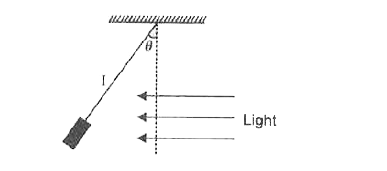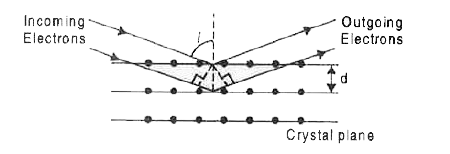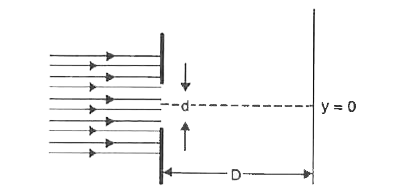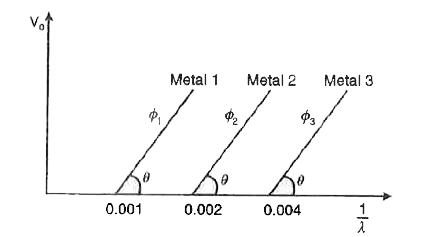MULTIPLE CHOICE QUESTIONS (LEVEL-II) from MODERN PUBLICATION PHYSICS (KANNADA ENGLISH) ELECTRONS & PHOTONS for Class 12
| Class 12 | PHYSICS |
| Chapter | ELECTRONS & PHOTONS |
| MODERN PUBLICATION PHYSICS (KANNADA ENGLISH) | MULTIPLE CHOICE QUESTIONS (LEVEL-II) |
| Medium | English |
| Academic Year | 2023-2024 |
Question 52
Statement I: Photoemission from a photosensitive metal is possible only if the incident radiation has a frequency above the threshold frequency.
Statement II : In photoelectric emission, the maximum energy of photoelectrons increases with increasing intensity of incident light. View SolutionQuestion 57
Direction : The questions 57, 58 and 59 are based on following paragraph : Radiation emitted when an electron jumps from n = 3 to n=1 orbit in H2 atom, fall on a metal to produce photoelectrons. Electrons fall on the metal surface with maximum K.E. in a direction perpendicular to a magnetic field of 1/320 T in a radius of 10m−3.
The K.E. of the electrons is View SolutionQuestion 58
Direction : The questions 57, 58 and 59 are based on following paragraph : Radiation emitted when an electron jumps from n = 3 to n=1 orbit in H2 atom, fall on a metal to produce photoelectrons. Electrons fall on the metal surface with maximum K.E. in a direction perpendicular to a magnetic field of 1/320 T in a radius of 10m−3.
Work function of metalView SolutionQuestion 59
Direction : The questions 57, 58 and 59 are based on following paragraph : Radiation emitted when an electron jumps from n = 3 to n=1 orbit in H2 atom, fall on a metal to produce photoelectrons. Electrons fall on the metal surface with maximum K.E. in a direction perpendicular to a magnetic field of 1/320 T in a radius of 10m−3.
Wavelength of radiation isView SolutionQuestion 60
Direction : The questions 60 and 61 are based on following paragraph :
An X-ray tube operated at a D.C, voltage of 40 kV produces heat at the target at the rate of 720 W. If 0.5% of the energy of the incident electron is converted into X-ray radiation, then (sp. charge is 1.8×1011C/kg).
Number of electrons striking the target per/sec is View SolutionQuestion 61
Direction : The questions 60 and 61 are based on following paragraph :
An X-ray tube operated at a D.C, voltage of 40 kV produces heat at the target at the rate of 720 W. If 0.5% of the energy of the incident electron is converted into X-ray radiation, then (sp. charge is 1.8×1011C/kg).
The velocity of the incident electron isView SolutionQuestion 62
Direction : The questions 62 and 63 are based on following paragraph :
de-Broglie wave associated with electron forms a standing wave when distance (d) between atoms of the array of material is 2Å. A similar standing wave is again formed, when distance is increased to 2.5Å.
Then energy of electron is View SolutionQuestion 63
Direction : The questions 62 and 63 are based on following paragraph :
de-Broglie wave associated with electron forms a standing wave when distance (d) between atoms of the array of material is 2Å. A similar standing wave is again formed, when distance is increased to 2.5Å.
Least value of distance (d) for which standing wave can be formed isView SolutionQuestion 64
The work function of caesium metal is 2.14 ev. When light of frequency 6×1014Hz is incident on the metal surface, photoemission of electrons occurs. What is the
(a) maximum kinetic energy of the emitted electrons,
(b) Stopping potential, and
(c) maximum speed of the emitted photoelectrons?View SolutionQuestion 65
The work function of caesium metal is 2.14 ev. When light of frequency 6×1014Hz is incident on the metal surface, photoemission of electrons occurs. What is the
(a) maximum kinetic energy of the emitted electrons,
(b) Stopping potential, and
(c) maximum speed of the emitted photoelectrons?View SolutionQuestion 66
The work function of caesium metal is 2.14 ev. When light of frequency 6×1014Hz is incident on the metal surface, photoemission of electrons occurs. What is the
(a) maximum kinetic energy of the emitted electrons,
(b) Stopping potential, and
(c) maximum speed of the emitted photoelectrons?View SolutionQuestion 89
Direction : Question number 89 contain Statement-1 and Statement-2. Of the four choices given after the statements, choose the one that best describes the two statements.
Statement-1: When ultraviolet light is incident on a photocell, its stopping potential is V0 and the maximum kinetic energy of the photoelectrons is Kmax. When the ultraviolet light is replaced by X-rays. Both V0 and Kmax increase.
Statement-2: Photoelectrons are emitted with speeds ranging from zero to a maximum value because of the range of frequencies present in the incident light.View SolutionQuestion 99
In a Thomson's set up for elm, the same high tension d.c. supply provides potential to anode for acceleration and also the positive voltage to the deflecting plate in the region of crossed fields. If the supply voltage is doubled, by what factor the magnetic field be increased to keep the electron beam undeflected ?View SolutionQuestion 118
Radiation of wavelength 180 nm eject photoelectrons from a plate whose work function is 2.0 eV. If a uniform magnetic field of flux density 5.0×10−5T is applied parallel to plate, what should be the radius of the path followed by electrons ejected normally from the plate with maximum energy: View SolutionQuestion 119
A potassium surface is placed 75 cm away from a 100 W bulb. It is found that energy radiated by the bulb is 5% of the input power. Consider each potassium atom as a circular disc of diameter 1Å and determine the time required for each atom to absorb an amount of energy equal to its work function of 2:0 eV: View SolutionQuestion 121
Two beams P and Q of light of the same wavelength fall upon the same metal surface causing photoemission of electrons. The photoelectric current produced by P is four times that produced by Q. Which of the following gives the ratio
wave amplitude of beam Pwave amplitude of beam Q?View SolutionQuestion 126
In a photoelectric set up, a point source of light of power 3.2×10−3 W emits monoenergetic photons of energy 5.0 eV. The source is located at a distance of 0.8 m from the centre of a stationary metallic sphere of work function 3.0 eV and of radius 8.0×10−3 m. The efficiency of photoelectron emission is one for every 106 incident photon. Assume that state is isolated and initially neutral and that the photoelectrons are instantly swept away after emission. Calculate the number of photoelectron emitted per sec, by sphere :View SolutionQuestion 128
A light source emitting three wavelength 5000Å,6000Å,7000Å has a total power of 10−3 m. W and the beam of diameter 2×10−3m. The power density is distributed equally amongst the three wavelengths. The beam shines normally on a metallic surface of area 104m2 which has a work function of 1.9 eV. Assuming that each proton liberates an electron, calculate the charge emitted per unit area in one second : View SolutionQuestion 129
Radiation of wavelength 180 nm eject photoelectrons from a plate whose work function is 2.0 eV. If a uniform magnetic field of flux density 5.0×10−5T is applied parallel to plate, what should be the radius of the path followed by electrons ejected normally from the plate with maximum energy: View SolutionQuestion 131
A cylindrical rod of some laser material 5×10−2m long and 10−2m diameter contains 2×102525 ions per m3. If on excitation all the ions in the upper energy level de-excite simultaneously emitting photons in the same direction, calculate the maximum energy contained in a pulse of radiation of wavelength 6.6×10−7m View SolutionQuestion 133
Fig. shows a small plane strip suspended from a fixed support through a string of length 1. A continuous beam of monochromatic light is incident horizontally on the strip and is completely absorbed. The energy falling on the strip per unit area per sec is P. The deflection of the string from the vertical, if the strip stays in equilibrium.
 View Solution
View SolutionQuestion 135
The radiation emitted when an electron jumps from n=3 to n = 2 orbit in a hydrogen atom, falls on a metal to produce photoelectron. The electron with maximum kinetic energy are made to move perpendicular to a magnetic field of 1320 T in a radius of 10m. The work function of the metal is :View SolutionQuestion 136
A monochromatic light source of frequency villuminates a metallic surface and ejects photoelectron. The electron with maximum energy are just able to ionize the hydrogen atom in the ground state. When the whole experiment is repeated with an incident radiation of frequency 5/6 v, the photoelectrons so emitted are able to excite the hydrogen atom beam which then emits a radiation of the wavelength 1215Å. Find the work function of the metal : View SolutionQuestion 150
Direction : Question Numbers. 150 and 151 are based on the following paragraph.
Wave property of electrons implies that they will show diffraction effects. Davisson and Germer demonstrated this by diffracting electrons from crystals. The law governing the diffraction from a crystal is obtained by requiring that electron waves reflected from the planes of atoms in a crystal interfere constructively (See figure).

Electrons accelerate by potential V are diffracted from a crystal. If d=1Å and i=30∘, V should be about (h=6.6×10−34Js,me=9.1×10−31kg,e=1.6×10−19C)View SolutionQuestion 151
Direction : Question Numbers. 150 and 151 are based on the following paragraph.
Wave property of electrons implies that they will show diffraction effects. Davisson and Germer demonstrated this by diffracting electrons from crystals. The law governing the diffraction from a crystal is obtained by requiring that electron waves reflected from the planes of atoms in a crystal interfere constructively (See figure).

If a strong diffraction peak is observed when electrons are incident at an angle i from the normal to the crystal planes with distance d between them (see tigure), de-Broglie wavelength λdB of electrons can be calculated by the relationship (n is an integer) View SolutionQuestion 152
In an experiment, electrons are made to pass through a narrow slit of width d comparable to their de-Brogile wavelength. They are detected on a screen at a distance D from the slit.

Which of the following graphs can be expected to represent the number of electrons N detected as a function of the detector position y(y = 0 corresponds to the middle of the slit)?View SolutionQuestion 154
Photoelectric effect experiments are performed using three different metal plates p, and r having work functions ϕP=2.0eV,ϕq=2.5eV and wavelengths of 550 nm, 450 nm and 350 nm with equal intensities illuminates each of the plates. The correct I-V graph for the experiment is (Take hc = 1240 eV nm)View SolutionQuestion 156
This question has Statement - 1 and Statement - 2. Of the four choices given after the statements, choose the one that best describes the two statements.
Statement-1 : A metallic surface is irradiated by a monochromatic light of frequency v>v0 (the threshold frequency). The maximum kinetic energy and the stopping potential are Kmax and V0 respectively. If the frequency incident on the surface doubled, both the Kmax and V0 are also doubled.
Statement-2 : The maximum kinetic energy and the stopping potential of photoelectrons emitted from a surface are linearly dependent on the frequency of incident light.View SolutionQuestion 159
A silver sphere of radius 1 cm and work function 4.7 eV is suspended from an insulating thread in free space. It is under continuous illumination of 200 nm wavelength of light. As photoelectrons are emitted, the sphere gets charged and acquires a potential. The maximum number of photoelectrons emitted from the sphere is A×10z (where 1<A<10). The value of 'Z' is View SolutionQuestion 160
This question has Statement 1 and Statement 2. Of the four choices given after the Statements, choose the one that best describes the two statements.
Statement 1. Davisson-Germer experiment established the wave nature of electrons.
Statement 2. If electrons have wave nature, they can interfere and show diffraction.View SolutionQuestion 162
The radiation corresponding to 3→2 transition of hydrogen atom falls on a metal surface to produce photoelectrons. These electrons are made to enter a magnetic field of 3×10−4T. If the radius of the largest circular path followed by these electrons is 10.0 mm, the work function of the metal is close to :View SolutionQuestion 163
Match List - I (Fundamental Experiment) with List - II (its conclusion) and select the correct option from the choices given below the list :
List-IList-II(A)Franc-Hertz Experiment.(i)Particle nature of light(B)Photo-electric(ii)Discrete energy levels of atom(C)Davison-Germer Experiment.(iii)Wave nature of electron(iv)Structure of atomView Solution


